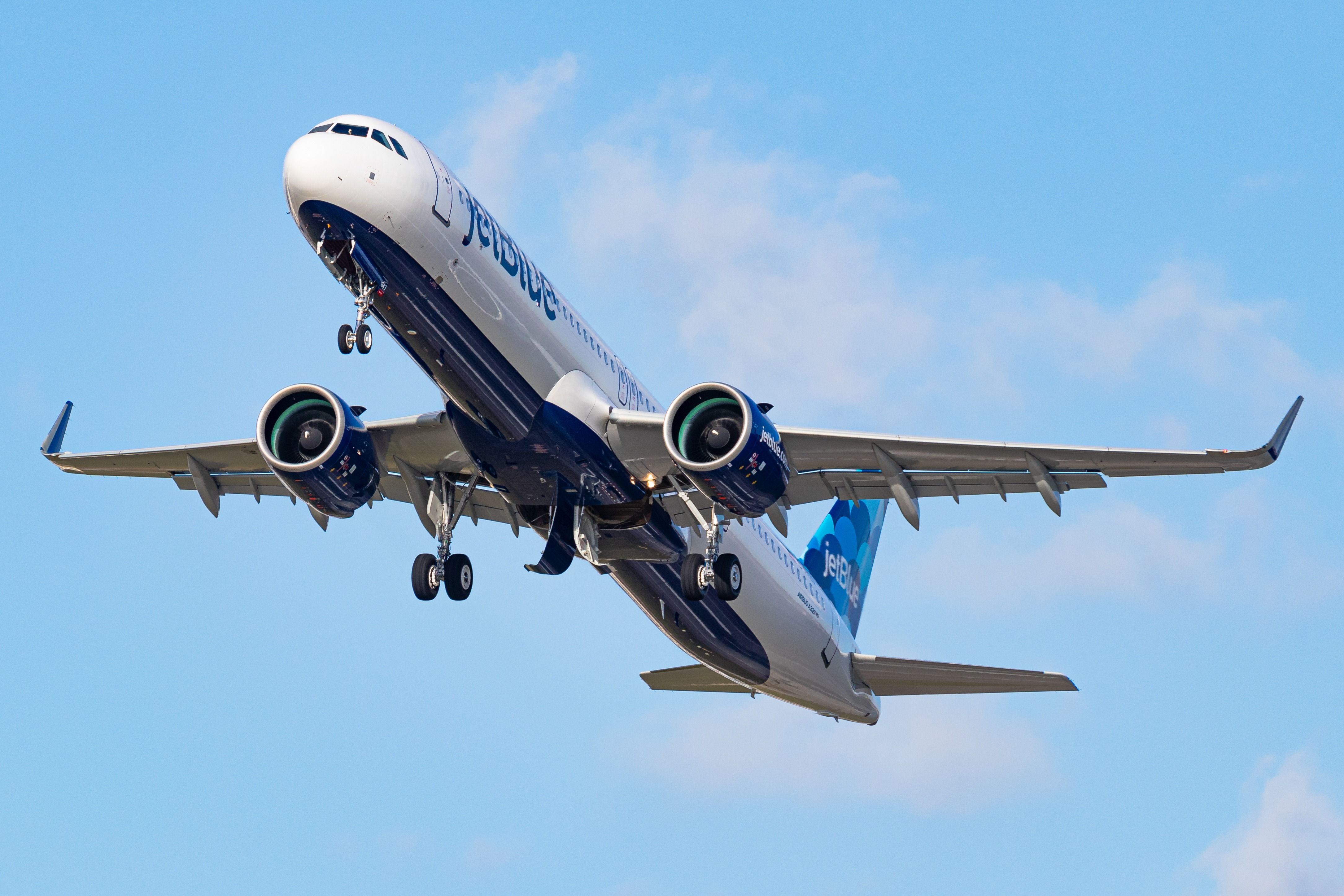JetBlue Flight 1760 Incident: The Untold Story You Need To Know
JetBlue Flight 1760 incident is a story that’s been buzzing around the aviation world, and for good reason. Imagine being on a plane, minding your own business, scrolling through TikTok or trying to finish that last episode of your favorite show, when suddenly chaos erupts. Sounds like a scene straight out of a Hollywood movie, right? But this isn’t fiction—it’s reality. The JetBlue Flight 1760 incident has left passengers, aviation enthusiasts, and even seasoned pilots talking about what went down. So, buckle up because we’re diving deep into the details you might not have heard yet.
Now, let’s get one thing straight: flying is generally safe. Airplanes are designed with layers upon layers of safety protocols, and pilots go through rigorous training to handle any situation. But even the safest systems can face unexpected challenges. This incident serves as a reminder that sometimes, even the best-laid plans can go awry. And when they do, it’s the response of the crew and passengers that truly matters.
But why should you care? Well, understanding what happened on JetBlue Flight 1760 isn’t just about satisfying your curiosity—it’s about learning from the experience. Whether you’re a frequent flyer or someone who only steps on a plane once in a blue moon, knowing how to handle emergencies can make all the difference. So, let’s break it down step by step, uncovering the truth behind the headlines.
- Helena Bonham Carter Partners The Fascinating Journey Of An Iconic Actress
- Unveiling The Mystique Of Creations Pyrrothian Lyxterand
Table of Contents
- Background of JetBlue Flight 1760 Incident
- Timeline of the Incident
- Crew Response and Passenger Safety
- Passenger Stories: What They Experienced
- Technical Details of the Aircraft
- Investigation and Findings
- Lessons Learned for Future Flights
- JetBlue’s Response and Actions
- The Importance of Aviation Safety
- Conclusion and Final Thoughts
Background of JetBlue Flight 1760 Incident
Let’s rewind the clock a bit and set the stage. JetBlue Flight 1760 was an ordinary flight scheduled to travel from New York’s JFK Airport to Fort Lauderdale, Florida. The flight, like many others, was carrying a mix of vacationers, business travelers, and families eager to reach their destinations. But little did anyone know that this particular journey would take an unexpected turn.
JetBlue itself is no stranger to the skies. Known for its customer-centric approach and affordable pricing, the airline has built a solid reputation over the years. However, even the most well-oiled machines can face hiccups. The incident involving Flight 1760 highlighted the importance of preparedness and adaptability in the face of unforeseen circumstances.
Why This Incident Matters
So, why exactly did this incident grab so much attention? For starters, it wasn’t just another delay or turbulence. This was a situation where the safety of everyone onboard was at stake. Passengers reported hearing loud noises, feeling the plane shake violently, and even seeing smoke inside the cabin. Scary stuff, right? It’s moments like these that test the mettle of both the crew and the passengers.
- Landscape Kdarchitects Roger Morph Revolutionizing Outdoor Spaces
- Vegamovie The Ultimate Destination For Movie Enthusiasts
Moreover, incidents like this raise questions about airline safety protocols, crew training, and how well-prepared airlines are to handle emergencies. While the aviation industry boasts an impressive safety record, every incident serves as a learning opportunity to improve and prevent similar occurrences in the future.
Timeline of the Incident
Alright, let’s dive into the nitty-gritty. Here’s a breakdown of what happened during the JetBlue Flight 1760 incident:
- Takeoff: The flight departed from JFK Airport as scheduled, with no initial signs of trouble.
- Mid-Flight: About halfway into the journey, passengers began noticing unusual sounds and vibrations. Some reported hearing a loud bang, followed by a sudden drop in cabin pressure.
- Emergency Procedures: The crew quickly sprang into action, initiating emergency procedures and preparing passengers for a possible diversion.
- Diversion: The flight was diverted to an alternate airport, where it made a safe landing. Emergency services were on standby to assist upon arrival.
Each step of the timeline is crucial in understanding how the situation unfolded and how it was managed. The quick thinking of the crew played a significant role in ensuring the safety of everyone onboard.
Crew Response and Passenger Safety
When things go south, it’s the crew that becomes the backbone of the operation. During the JetBlue Flight 1760 incident, the crew demonstrated remarkable professionalism and composure under pressure. Here’s how they handled the situation:
- Communication: The pilots promptly informed passengers about the situation, keeping them updated throughout the ordeal.
- Emergency Protocols: Flight attendants ensured that all passengers were following safety procedures, such as securing their seatbelts and preparing for a potential evacuation.
- Passenger Comfort: Despite the chaos, the crew did their best to keep passengers calm and reassured them that everything was being done to ensure their safety.
It’s worth noting that the crew’s training kicked in exactly when it was needed most. Their ability to remain calm and focused in a high-stress situation is a testament to the rigorous preparation they undergo.
Passenger Role in Emergencies
While the crew plays a critical role, passengers also have responsibilities during emergencies. In the case of JetBlue Flight 1760, passengers followed instructions diligently, which contributed to the successful handling of the situation. Key takeaways for passengers include:
- Listening carefully to pre-flight safety briefings.
- Staying calm and following crew instructions without hesitation.
- Assisting others if possible, especially those who may be more vulnerable, like children or elderly passengers.
Passenger Stories: What They Experienced
Now, let’s hear from the people who were actually there. Passenger testimonials paint a vivid picture of what it was like to be on JetBlue Flight 1760 during the incident. Here are some firsthand accounts:
“It felt like the plane was shaking apart.” – Sarah L., a frequent flyer, described the moment she heard the loud bang and felt the aircraft shudder. She mentioned how the crew’s calm demeanor helped ease her fears.
“I was scared, but I knew we were in good hands.” – John D., a first-time flyer, praised the crew for their reassurance and guidance during the emergency.
These stories highlight the importance of trust and communication between passengers and crew during critical moments. They also serve as a reminder that even in the face of adversity, human resilience can shine through.
Technical Details of the Aircraft
For those who love the technical side of things, let’s break down the specifics of the aircraft involved in the JetBlue Flight 1760 incident. The plane was a Boeing 737, a workhorse of the aviation industry known for its reliability and efficiency.
What Went Wrong? Initial investigations pointed to a potential issue with one of the engines. While the exact cause is still under review, experts believe that a component failure may have triggered the chain of events that led to the emergency landing.
How Did the Aircraft Respond? Modern airplanes are equipped with advanced systems designed to handle emergencies. In this case, the plane’s redundancy features kicked in, allowing the pilots to maintain control and safely land the aircraft.
Why Aircraft Redundancy Matters
Redundancy in aviation refers to having backup systems in place to ensure that if one system fails, another can take over. This concept is crucial in maintaining safety and preventing catastrophic outcomes. The JetBlue Flight 1760 incident is a prime example of how redundancy can save lives.
Investigation and Findings
After the incident, aviation authorities launched a thorough investigation to determine the root cause. While the full report is still pending, preliminary findings suggest that maintenance issues may have played a role.
Key Points from the Investigation:
- Regular maintenance checks are essential to prevent similar incidents in the future.
- Airlines must ensure that all components are thoroughly inspected and replaced as needed.
- Training programs for pilots and crew should include scenarios that simulate real-world emergencies.
The investigation serves as a wake-up call for the aviation industry, emphasizing the need for continuous improvement and vigilance.
Lessons Learned for Future Flights
Every incident, no matter how minor or major, offers valuable lessons. Here are some key takeaways from the JetBlue Flight 1760 incident:
- Preparation is Key: Both airlines and passengers must be prepared for emergencies. This includes regular training for crew and paying attention to safety briefings for passengers.
- Communication Saves Lives: Clear and concise communication between the crew and passengers can make all the difference in managing a crisis.
- Technology Enhances Safety: Investing in advanced technologies and systems can help prevent and mitigate emergencies.
These lessons underscore the importance of a proactive approach to aviation safety. By learning from past incidents, we can strive for a safer future.
JetBlue’s Response and Actions
In the aftermath of the incident, JetBlue issued a statement addressing the concerns of passengers and the public. The airline expressed its commitment to ensuring the safety and well-being of all those involved. Here’s what they did:
- Provided support and accommodations for affected passengers.
- Conducted a thorough review of their maintenance protocols.
- Enhanced crew training programs to better prepare for emergencies.
JetBlue’s response reflects their dedication to transparency and accountability. It’s reassuring to see airlines taking responsibility and implementing changes to prevent similar incidents from occurring.
The Importance of Aviation Safety
Aviation safety is a topic that deserves our attention. While incidents like the JetBlue Flight 1760 incident are rare, they highlight the importance of maintaining high safety standards. Here’s why aviation safety matters:
- It protects the lives of millions of passengers who rely on air travel daily.
- It ensures the reliability and efficiency of global transportation networks.
- It fosters trust between airlines and their customers.
As passengers, we can do our part by staying informed and following safety guidelines. Together, we can contribute to a safer aviation industry.
Conclusion and Final Thoughts
Wrapping things up, the JetBlue Flight 1760 incident serves as a powerful reminder of the importance of safety, preparedness, and teamwork. While it was undoubtedly a stressful experience for those involved, it also demonstrated the resilience and professionalism of the crew and passengers.
As we move forward, let’s take the lessons learned from this incident and apply them to our everyday lives. Whether you’re a seasoned traveler or someone who’s just starting to explore the world, remember that safety is a shared responsibility.
So, what’s next? We invite you to share your thoughts in the comments below. Did you experience a similar situation? What did you learn from it? And don’t forget to check out our other articles for more insights into the world of aviation. Fly safe, everyone!



Detail Author:
- Name : Earlene Stokes
- Username : eboyer
- Email : berry.padberg@cremin.net
- Birthdate : 1988-08-15
- Address : 441 Hackett Freeway Gleichnerstad, PA 95869-9174
- Phone : (541) 910-0319
- Company : Dietrich-Powlowski
- Job : Stringed Instrument Repairer and Tuner
- Bio : Numquam et cumque pariatur quis aliquam amet iure sit. Voluptas dolor est quas tempore et corporis debitis. Eum dolor necessitatibus beatae quia expedita. Ullam omnis qui itaque.
Socials
tiktok:
- url : https://tiktok.com/@ardith_fay
- username : ardith_fay
- bio : Tempore optio dolor fuga et adipisci assumenda veritatis.
- followers : 3891
- following : 2406
twitter:
- url : https://twitter.com/ardith.fay
- username : ardith.fay
- bio : Iure repudiandae unde incidunt harum nesciunt nulla. Officia sunt nobis nesciunt distinctio natus eveniet.
- followers : 2084
- following : 552
facebook:
- url : https://facebook.com/afay
- username : afay
- bio : Voluptatibus vel officia esse sit enim minima. Enim fugit qui sit aut natus.
- followers : 4263
- following : 1778